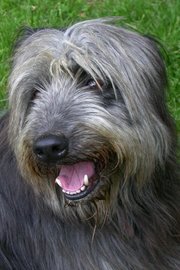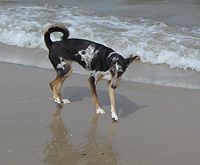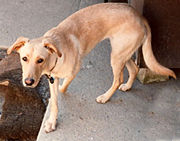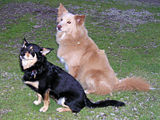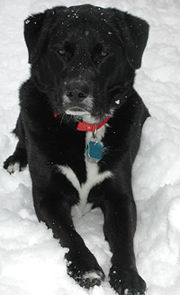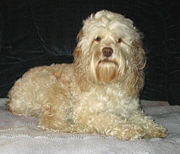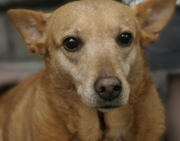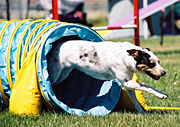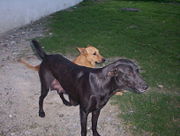Mixed-breed dog
2008/9 Schools Wikipedia Selection. Related subjects: Mammals
A mixed-breed dog (also called a mutt, mongrel, tyke, cur, or random-bred dog) is a dog that has characteristics of two or more types of breeds, or is a descendant of feral or pariah dog populations. The term crossbreed refers to puppies produced by the breeding technique of breeding known dogs of two different purebred dog breeds for some specific reason. The term "mutt" generally refers to a dog of unknown descent. Dogs interbreed freely, except where extreme variations in size exist, so mixed-breed dogs vary in size, shape, and colour, making them hard to classify physically.
Terms for mixed-breed dogs
There are a profusion of words and phrases used for dogs that are not purebred. The words cur, tyke, and mongrel are some used, but generally viewed as derogatory in North America. In the United Kingdom mongrel is the unique technical word for a mixed-breed dog, and is not a term of disparagement. North American owners generally prefer mix or mixed-breed. Mutt is also used (in the U.S.A and Canada), usually in an affectionate manner. In Hawaii, mixed breed dogs are referred to as poi dog, and in the Bahamas, they call them Pot Cakes (referring to the table-leftovers they are fed). Some American registries and dog clubs that accept mixed-breed dogs use the breed name All American. In South Africa, the tongue-in cheek expression pavement special is sometimes used as a description for a mixed-breed dog. Random-bred dog, mutt, and mongrel are often used for dogs who result from breeding without the supervision or planning of humans, especially after several generations, whereas crossbreed implies mixes of known breeds, sometimes deliberately mated.
In Brazil and the Dominican Republic, the name for mixed-breed dogs is vira-lata (vira: to turn, to bring down; lata: tin can, trash can) because there are dogs without owners that feed on urban garbage on the streets, and often knock over trash cans to reach the food.
Slang terms are also common. Heinz 57 is often used for dogs of uncertain ancestry, in a playful reference to the "57 Varieties" slogan of the H. J. Heinz Company. In some countries, bitsa (or bitzer) is common, meaning "bits o' this, bits o' that". A fice or feist is a small mixed-breed dog. In Newfoundland, a smaller mixed-breed dog is known as a cracky, hence the colloquial expression "saucy as a cracky" for someone with a sharp tongue.
To complicate matters, many owners of crossbreed dogs identify them—often facetiously—by an invented breed name constructed from parts of their parents' breed names. These are known as portmanteau names. For example, a cross between a Pekingese and a Poodle is called a Peekapoo, possibly a play on peek-a-boo, along with the Goldendoodle, a cross between a poodle and a golden retriever. As another example, one of the UK's Queen Elizabeth's famous Corgis mated with her sister's Dachshund, and the resulting offspring were referred to as Dorgis.
Appearance
Dogs that are descended from many generations of mixes are typically light brown or black and weigh about 18 kg (40 lb). They typically stand between 38 and 57 cm (15 and 23 inches) tall at the withers.
Determining ancestry
Guessing a mixed-breed's ancestry is difficult for even knowledgeable dog observers, because mixed breeds have much more genetic variation than among purebreds. For example, two black mixed-breed dogs might each have recessive genes that produce a blond coat and, therefore, produce offspring looking unlike their parents.
Starting in 2007, blood samples and cheek swabs have become available to the public to narrow down the ancestry of mixed-breed dogs. The companies claim their DNA-based diagnostic test that can genetically determine the breed composition of mixed breed dogs. These tests are still limited in scope because only a small number of the hundreds of dog breeds have been validated against the tests, and because the same breed in different geographical areas could have different genetic profiles. Also, the tests do not test for breed purity, but for genetic sequences that are common to certain breeds. With a mixed-breed dog, the test is not proof of pure-bred ancestry, but rather an indication that those dogs share common ancestry with certain purebreds.
Health
The theory of hybrid vigor suggests that as a group, dogs of varied ancestry will be healthier than their purebred counterparts. In purebred dogs, intentionally breeding dogs of very similar appearance over several generations produces animals that carry many of the same alleles, some of which are detrimental. This is especially true if the dogs are closely related. This inbreeding among purebreds has exposed various genetic health problems not readily apparent in less uniform populations. Mixed-breed dogs are more genetically diverse due to the more haphazard nature of their parents' mating. "Haphazard" is not the same as "random" to a geneticist. The offspring of such matings are less likely to express certain genetic disorders because there is a decreased chance that both parents carry the same detrimental recessive alleles. However, some deleterious recessives are common across many seemingly unrelated breeds, and therefore merely mixing breeds is no guarantee of genetic health.
Crossbreeding to take advantage of the increased chance that a recessive detrimental allele will only be inherited from one parent, and therefore not expressed in the phenotype of the offspring, is only one strategy breeders can use to decrease the incidences of genetic faults. For example, large dogs such as the German Shepherd Dog often suffer from hip dysplasia, a multigene trait strongly affected by environment. Mating a German Shepherd, a breed known to have about a 20% incident of this disease (ref:OFA), with a dog of a different breed not known to suffer from it dysplasia like the Greyhound, reduces the likelihood that the cross-breed produced will suffer from hip dysplasia. Mate the same German Shepherd to an Otterhound (dysplasia incidence about 52%) or to a small dog such as a Pug (62%) or a Norfolk Terrier (37%), and the outcome might be considerably different. Breeding dogs that have been tested free of dysplasia offers a similar result, with the added benefit of producing offspring that are less likely to carry the defect, unexpressed.
Knowing the disease incidence in the breed, and the genetic history of the individual, is ultimately important in dog breeding. Having the parental dogs genetically tested for defects known to be troublesome to their breed (or breeds, in the case of mixed parentage) will do as much, or more, than simply choosing dissimilar individuals with functional reproductive tracts. Genetic health must be approached from many angles. Some schemes are effective for the short-term, but disastrous in the long. Others are slow to take effect, but that effect is long-lasting.
Mating two different purebreds to decrease the likelihood of inheriting a particular genetic disease, without consideration of all the other physical and mental attributes that comprise a suitable pet and companion, is as likely to fail as any other single-trait selection scheme. Overall, hybrid vigor is not associated with any of the traits in dogs that make them suitable companions. At the same time, there's nothing about a the genetic background of mixedbreed dog that makes it an inherently poorer companion than its purebred counterparts. Mixed breed dogs can make kind and caring companions and are often very good around children.
There is no guarantee of good genetic health, or temperment, of any dog, purebred or otherwise, as not all damaging genes are recessive, and there are relatively few single-gene traits. Also, of course, purebred and mixed-breed dogs are equally susceptible to nongenetic ailments, such as rabies, distemper, injury, and infestation by parasites.
Types of mixed breeding
Recognized dog breeds are a result of human selection in that dogs were traditionally bred for specific functions. Most existing dog breeds began as mixed breeds, either by random occurrence or by deliberate crosses of existing breeds. Encouraging desirable traits and discouraging others, breeders sought to create their ideal appearance or behavior, or both, for dogs, and, additionally, to ensure that the dogs could consistently produce offspring with the same appearance or behavior. Mixing breeds can lead to desirable results, especially in the hands of an expert breeder. On the other hand, inexperienced crossbreeders can produce disastrous results. For example, the offspring of an obsessive Border Collie and an energetic, destructive Terrier could be dogs whose behaviour is so erratic that would make the dog a liability.
Mixed-breed dogs can be divided roughly into three types:
- Crossbreed dogs, which are mixtures of two recognized breeds. Dogs that result from two different purebred parents are known as crossbreeds. Some crossbreeds have traits that make them popular enough to be frequently bred deliberately, such as the Cockapoo—a cross between a Poodle and a Cocker Spaniel—and the Labradoodle, which crosses a Labrador Retriever with a Poodle. Other crossbreeds occur when breeders are hoping to create new breeds to add and reinforce characteristics from one breed into another breed. Most crossbreedings, however, occur accidentally.
- Mixes that show characteristics of two breeds or more breeds. A mix might have some purebred ancestors, or might come from a long line of mixed-breeds. These dogs are usually identified by the breed they most resemble, such as a "Lab mix" or "Collie-Shepherd", even if their ancestry is unknown.
- The generic pariah dog, or feral Canis lupus familiaris, where non-selective breeding has occurred over many generations. The term originally referred to the wild dogs of India, but now refers to dogs belonging to or descended from a population of wild or feral dogs. The Canaan Dog is an example of a recognized breed with pariah ancestry. Pariah dogs tend to be yellow to light brown and of medium height and weight. This may represent the appearance of the modern dog's ancestor. DNA analysis has shown pariah dogs to have a more ancient gene pool than modern breeds.
There is no scientific justification for the belief that a purebred bitch is in any way tainted after mating with a dog of another breed. Future matings with dogs of the same breed will produce purebred puppies.
Mixed breeds in dog sports
Mixed-breed dogs can excel at dog sports, such as obedience, dog agility, flyball, and frisbee. Often, highly energetic mixed-breeds are left with shelters or rescue groups, where they are sought by owners with the caring, patience, and drive to train them for dog sports, turning unwanted dogs into healthy, mentally and physically stimulated award winners.
Until the early 1980s, mixed-breed dogs were usually excluded from obedience competitions. However, starting with the American Mixed Breed Obedience Registry (AMBOR) and the Mixed Breed Dog Clubs of America (MBDCA), which created obedience venues in which mixed-breed dogs could compete, more opportunities have opened up for all dogs in all dog sports. Most dog agility and flyball organizations have always allowed mixed-breed dogs to compete. Today, mixed breeds have proved their worth in many performance sports.
In conformation shows, where dogs' conformation to a breed standard is evaluated, mixed-breed dogs normally cannot compete. For purebred dogs, their physical characteristics are judged against a single breed standard. Mixed-breed dogs, however, are difficult to classify except according to height; there is tremendous variation in physical traits such as coat, skeletal structure, gait, ear set, eye shape and colour, and so on. When conformation standards are applied to mixed-breed dogs, such as in events run by the MBDCA, the standards are usually general traits of health, soundness, symmetry, and personality. The Kennel Club (UK) operates a show called Scruffts (a name derived from its prestigious Crufts show) open only to mixed-breeds in which dogs are judged on character, health, and temperament. Some kennel clubs, whose purpose is to promote purebred dogs, still exclude mixed breeds from their performance events. The AKC and the FCI are two such prominent organizations. However, the AKC does allow mixed breed dogs to earn their Canine Good Citizen award.
Advantages and drawbacks
The mature appearance and behaviour of purebred puppies is more predictable than that of mixed breeds, including cross-breeds. With purebred dogs, the genetic variations are well documented and a breeder has a fair estimation of what type of offspring a given pair will produce. Still, there is variation within breeds; for example, two champion sheep-herding Border Collies might produce offspring with no interest in sheep herding.
Some trainers believe mixed-breeds exhibit higher average intelligence than purebreds, but others believe mixes are no more intelligent than purebreds. Both sets feature both slow learners and dogs with high learning capacity. For example, Benji, the hero in a series of films named for him, was a mixed-breed terrier.
Many people enjoy owning mixed breeds, valuing their unique appearance and characteristics. While purebred dogs exhibit little variability of appearance within their breed, mixed-breed dogs exhibit often unique appearances. Although some dog owners prefer the status of owning a specific breed of dog or have a nostalgic attachment to a breed they wish to acquire, many others enjoy mixed-breed dogs that exhibit characteristics similar to their favorite breeds; in fact, with a mixed-breed, they can enjoy some aspects of appearance and personality of two favorite breeds with a single dog. There is usually an abundant supply of mixed-breed dogs wanting owners, available at negligible prices, while pedigreed dogs can cost hundreds or thousands of dollars and reputable breeders can be hard to find.
Some owners value a dog's pedigree as a status symbol and, therefore, have no use for mixed-breed dogs; others particularly appreciate the physical or behavioural traits of certain breeds; still others ignore pedigree and, instead, value a dog's personality and health.
Local animal shelters adopt out dogs of both purebred and mixed ancestry, emphasizing each dog's personality and suitability as a companion for each potential owner's lifestyle.
Famous mutts
- Benji
- Muttley in Dastardly and Muttley in Their Flying Machines
- Tramp in Lady and the Tramp
